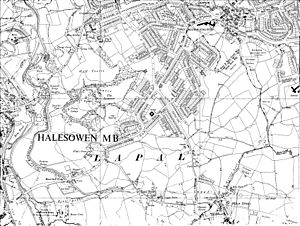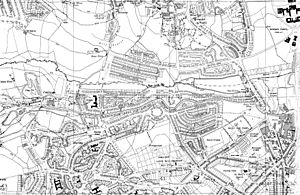Lapal Tunnel facts for kids
| Overview | |
|---|---|
| Location | West Midlands, England |
| Coordinates | 52°26′42″N 2°00′06″W / 52.4450°N 2.0017°W |
| OS grid reference | SO998830 |
| Status | Closed |
| Waterway | Dudley No. 2 Canal |
| Start | 52°26′45″N 2°01′39″W / 52.4458°N 2.0275°W |
| End | 52°26′39″N 1°58′33″W / 52.4442°N 1.9759°W |
| Operation | |
| Closed | 1917 |
| Technical | |
| Design engineer | William Underhill |
| Construction | 1798 |
| Length | 3,795-yard (3,470 m) |
| Tunnel clearance | 6 feet (1.8 m) |
| Width | 7 feet 3 inches (2.2 m) |
| Towpath | no |
| Boat-passable | no |
The Lapal Tunnel (sometimes spelled Lappal Tunnel) is a very long canal tunnel in the West Midlands, England. It is no longer used. This tunnel is about 3,470 meters (3,795 yards) long. It was built as part of the Dudley No. 2 Canal and gets its name from the nearby area of Lapal.
Contents
A Look Back: The Lapal Tunnel's Story
The Lapal Tunnel was built in 1798 by an engineer named William Underhill. It was made of brick and was quite narrow. There was no path for horses to walk beside the canal (called a towpath).
Tunnel Size and How Boats Moved
The tunnel was only about 2.2 meters (7 feet 3 inches) wide. This was barely wider than the boats themselves. It was also quite low, only about 1.8 meters (6 feet) high.
Because there was no towpath, people had to move the boats through the tunnel by "legging." This meant they would lie on their backs on the boat. Then, they would push against the tunnel walls with their feet. This helped to slowly move the boat forward. It took about three hours to get a boat through the tunnel this way.
In 1841, a steam engine was built at the Halesowen end of the tunnel. This engine helped to fill the tunnel with water. Special gates at each end could be opened to help boats move along more easily.
Why the Tunnel Closed
The Lapal Tunnel had many problems with parts of it collapsing. In 1917, a big collapse happened because of mining subsidence. This means the ground above the tunnel sank due to mining activity. After this, the tunnel was closed down.
Today, the tunnel runs under Lapal, the M5 motorway (near junction 3), and Woodgate Valley Country Park. The canal section between Halesowen and Selly Oak is also not used anymore. Some parts of it have even been filled in. It was decided that fixing the tunnel would be too expensive.
A short part of the canal that cannot be used by boats still exists. It is in the grounds of the Leasowes. This was once a garden belonging to the poet William Shenstone. Now, it is a public park and a golf course.
Nearby Canals and Tunnels
To the north of Halesowen, the Dudley Canal is in good condition. Boats still use it to reach Hawne Basin. This part of the canal includes the Gosty Hill Tunnel. This tunnel is much shorter than the Lapal Tunnel, at about 509 meters (557 yards). It was built at the same time as the Lapal Tunnel and has similar dimensions.
Future Plans: Restoring the Canal
The Lapal Canal Trust is a group working to bring back the lost canal. They want to make it possible for boats to use the canal again. Their goal is to restore the canal up to the tunnel from both the Halesowen and Selly Oak ends.
New Ideas for the Tunnel
The Trust originally hoped to restore the tunnel itself. However, in May 2007, experts suggested a different plan. They recommended that the tunnel should not be restored. Instead, they suggested building a new path for the canal that goes "up-and-over" the hill. This new path would use locks to raise and lower boats.
In February 2012, new plans were made for the Selly Oak area. These plans included a section of the canal that boats could use. This new section would connect to the Worcester and Birmingham Canal. It would also reach the recently rebuilt Harborne Lane bridge.



